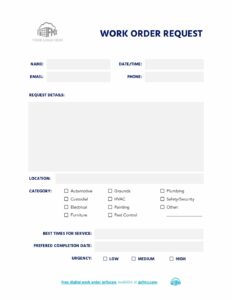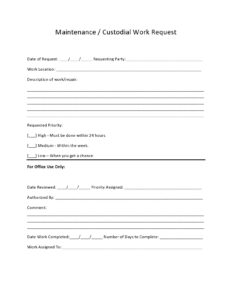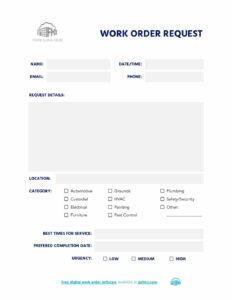Utilizing such a structured system offers several key advantages. It facilitates clear communication between those requesting maintenance and those responsible for carrying it out. Proper documentation enables efficient scheduling and prioritization of tasks, preventing delays and minimizing disruptions. Furthermore, a comprehensive record of completed maintenance activities simplifies reporting, analysis, and future planning. This ultimately contributes to improved resource allocation and cost control.
This article will explore the various components of these valuable tools, offer practical guidance on their implementation, and discuss best practices for maximizing their effectiveness within an organization.
Key Components of a Maintenance Request Log
Effective maintenance management relies on detailed information capture. A well-designed request log incorporates several essential components to ensure comprehensive documentation and efficient processing.
1. Request Date: The date the maintenance request was submitted. This information assists with tracking response times and identifying potential trends.
2. Requester Information: Details about the individual submitting the request, such as name, department, and contact information. This facilitates communication and clarification if needed.
3. Location: The precise location requiring maintenance, including building, floor, room number, or specific equipment identifier. This ensures maintenance personnel can quickly locate the issue.
4. Description: A clear and concise description of the problem. Including specific details, such as sounds, smells, or visual observations, can aid in accurate diagnosis.
5. Priority Level: An assigned priority level (e.g., low, medium, high, critical) indicating the urgency of the request. This helps prioritize tasks and allocate resources effectively.
6. Assigned Personnel: The name(s) of the individual(s) or team responsible for addressing the request. This ensures accountability and facilitates tracking progress.
7. Status: The current status of the request (e.g., submitted, in progress, completed, pending). This provides a real-time overview of maintenance activities.
8. Completion Date: The date the maintenance task was completed. This information supports performance analysis and record-keeping.
These elements provide a standardized framework for documenting, tracking, and managing maintenance requests, contributing to improved efficiency and streamlined operations.
How to Create a Maintenance Request Log Template
Creating a standardized template ensures consistency and completeness in maintenance request documentation. Several methods and tools can be employed for template creation.
1: Determine Required Information: Analyze existing maintenance processes to identify the essential data points for effective tracking and management. This typically includes request date, requester information, location, description, priority, assigned personnel, status, and completion date.
2: Choose a Format: Select a suitable format for the template. Common options include spreadsheets, word processing documents, or dedicated maintenance management software. The chosen format should facilitate easy data entry, organization, and reporting.
3: Design the Layout: Structure the template with clear headings and fields for each data point. Ensure the layout is logical and easy to navigate for both requesters and maintenance personnel.
4: Implement Input Validation: Where possible, incorporate input validation to ensure data accuracy and consistency. This might include dropdown menus for predefined options or mandatory fields for critical information.
5: Establish Clear Procedures: Develop clear procedures for submitting, processing, and updating maintenance requests. This includes defining roles and responsibilities for all involved parties.
6: Train Personnel: Provide training to all personnel involved in using the template, ensuring they understand how to complete it accurately and follow established procedures.
7: Regularly Review and Refine: Periodically review the template and associated procedures to identify areas for improvement. This iterative approach ensures the template remains relevant and effective in supporting maintenance operations.
A well-designed template, coupled with clear procedures and adequate training, promotes efficient maintenance management, contributing to reduced downtime and improved facility upkeep.
Effective facility management hinges on streamlined processes and accurate documentation. A well-implemented, standardized form for documenting maintenance requests provides the foundation for efficient task management, communication, and resource allocation. From facilitating clear communication between requesters and maintenance teams to enabling data-driven decision-making, a comprehensive system offers significant advantages. Key components such as request date, location details, problem descriptions, assigned personnel, and status updates contribute to a clear and actionable record of maintenance activities. Careful consideration of template design, data input methods, and established procedures further enhances the system’s effectiveness.
Organizations prioritizing proactive maintenance and optimal resource utilization should recognize the value of a robust tracking system. By implementing and refining such a system, organizations can contribute to improved operational efficiency, reduced downtime, extended asset lifecycles, and ultimately, a more sustainable approach to facility management. This proactive approach not only addresses immediate maintenance needs but also establishes a framework for continuous improvement and long-term cost savings.


